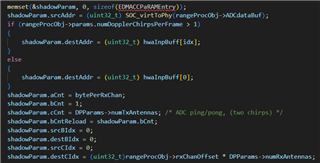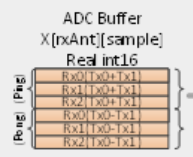Hello! I have a question while reviewing the range processing DPU source code, regarding to the EDMA transmission between ADC buffer and HWA.
In the function rangeProcHWA_ConfigEDMA_DataIn(), the EDMA is configured as follows:

My questions are:
- Why is DPParams->numTxAntennas the value for shadowParams.cCnt?
- Why shadowParam.srcAddr are the same for the two parameter sets? I'm assuming that one is for the transmitting the ping buffer while the other is for the pong buffer.
I'm assuming that the ADC buffer is in Single-Chirp Mode, which means that each Tx chirp will trigger the EDMA transmission for 3 Rx channels ADC data. And the bytePerRxChan matches this configuration:

From the range processing DPU block diagram, the ping and pong ADC buffers are adjacent:

It confuses me that if shadowParams.cCnt is 2 when 2 Tx antennas are used, isn't the EDMA accessing the pong ADC buffer as well when transmitting the ping buffer and vice versa?
Thank you!


